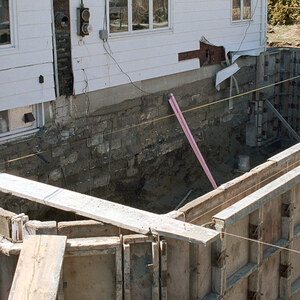Heating a 2nd home when not there
I have a 650 sf cabin used as a summer home, on the water in Washington state, with a kitchen, sleeping loft, and an enclosed bathroom. The cabin has a cathedral ceiling with the peak at about 19ft high, with a ceiling fan. The only heat source when we’re there is a small propane fireplace. The 4 walls of the cabin were done with the Arxx insulated concrete form system, up to 12′ high, with the roof rafters taking off from there.
What is the best, easiest, cheapest, safest way to provide some heat in the place when we’re not there for several days or weeks? I don’t want to leave the propane fireplace on. Last winter, our first, I used a 24 hour timer on a free-standing water-filled heater, going on and off 3 times day. Is this a good method? I’d like to keep the temperature at about 55 to 60 degrees.
Because of the high ceiling and all the heat being up high, I assume a thermostat on some kind of heater would never shut off.
Any suggestions?


















Replies
Others may respond, and often includes a link to a site.......heatinghelp.com?
It's Never Too Late To Become
What You Might Have Been
[email protected]
This will probably lead to argumentive discussion.
I would not heat it . I would set it up for easy winterazation like a travel trailer.
Make a bypass of the hot water heater and drain it . From the water sourse out side the building make a tee and a cut off which can shut the supply off and open the house to pump in rv antifreeze. Drain the commode tank before hand and shut off supply . Pour a cup of regular antifreeze in toilet . Bring in antifreeze with a pump to all faucets till the water gets "pink". The pink lost will suffice the drains.
I have a fourwheeler tank of 30 gallons that has a sprayer . 3 to 5 gallons will winterize the cabin.
Why would you want to heat it ?
Tim
Edited 10/6/2005 6:46 pm ET by Mooney
I second the winterization suggestion. I take care of my sister's 500 sqft place in the mountains of NC. Unless you are going up there to use it thru the winter it makes more sense to shut it down. I blow out the lines and use RV antifreeze in appliances and traps. It was built to be winterized with a drain in the chase where water comes in from the system. I take all things that would freeze down the hill when I leave. We put out containers of damp-rid to help with moisture.
I think your heater might be oil filled, not water. At least I hope so. I have several of the "radiator looking" jobs that are oil filled.
I agree with others who have said winterize if you're not going to be there all winter. One unmentioned benefit of not heating it in the winter is that you won't have to worry about roof leaks due to ice dams forming on the roof.
But if you insist on heating it, electric baseboard heaters are the simplest, safest method. I can't speak about the cost of that, as I have no idea how your electric rates compare to ours.
Install a heater in each area which contains any piping or has an adjoining wet wall. When possible, close the door (bathrooms, for instance). Concentrate the heat in the plumbed parts of the house; let the rest stay cold or cool. Leave the ceiling fan running on low, too.
Make sure you don't leave any canned goods in the pantry or cupboards (or fridge!)....
Dinosaur
A day may come when the courage of men fails,when we forsake our friends and break all bonds of fellowship...
But it is not this day.
Since you have very well insulated walls (ARXX) I'm wondering how cold the place will get if you do nothing. When you say on the water, is that ocean or other? Is it cloudy or sunny there in the winter? By keeping window shades open on the south facing side of the house it may stay well above freezing all winter. I know a fellow in Wyoming who has a shop with ARXX walls and if it's zero outside it's about 40 inside with no other heat other than a few largish windows on the south side.
I think you must have meant that post for AmosA, the O.P.
Dinosaur
A day may come when the courage of men fails,when we forsake our friends and break all bonds of fellowship...
But it is not this day.
I have a similar situation in my house, although it is a bit bigger (1500 sq. ft). We have sloped pex water supply lines connected to a monoblock system, and I can drain the entire house back to the monoblock in about 5 minutes. The monoblock sits in a basement utility room which has two sub grade walls and two well insulated walls, as well as an insulated ceiling. I keep this room warm with two electric space heaters. It only takes about 500 watts from one of the heaters to keep it at about 45 degress, and the other is set on a thermostat on a different circuit just in case the first one takes a vacation. Seems to work fine unless we have an extended power outage, but then most solutions won't work if you have an extended power outage.
The winterization thing can be a real hassle, and I can understand why you don't want to do it. But 60 degrees is awful warm for an unoccupied house. Heck, we keep our house not much warmer than this in the winter (thermo is set for 65). Why so warm?
I'm not sure about the winterizing solution if "when we're not there for several days or weeks"
How cold does it get there?
And what are you trying to keep warm?
Re heat stratification: run a small fan or ceiling fan and take some test temp measurements top and bottom.
I'd get two of the dri z air type heaters that people use to keep their boats dry
one going all the time - another maybe on a timer for sundown hrs
we have a laundry room that has no heating source and we hang clothes to dry using two of these in winter ( when clothes are hung ) and open windows in the drier months
very little energy use and it seems to me you need to think of dryness more than heat
my cabin is in Packwood Wa . i turn my electric heaters to 50 an forget it
We have a similar cabin in Alaska. We turn the water off (valve is buried 10 feet deep), drain the water lines, and pour antifreeze in the traps. And then forget about it all winter. No condensation, no ice dams, etc.